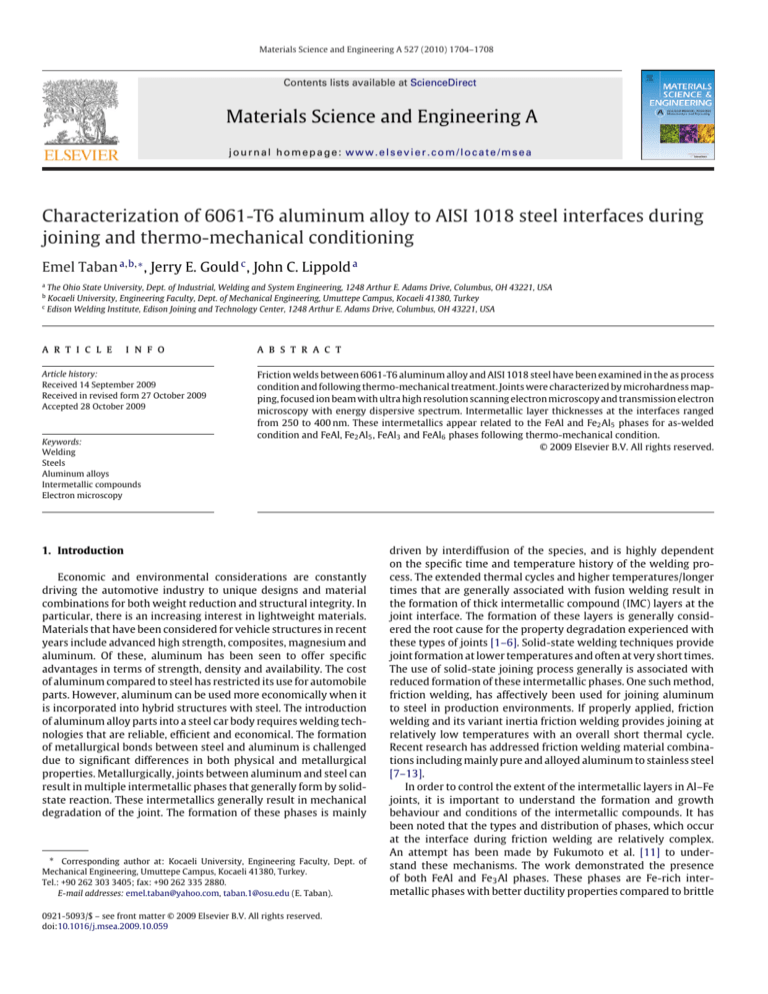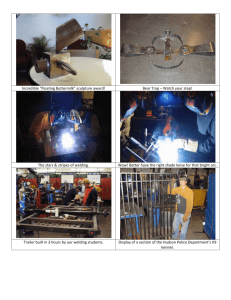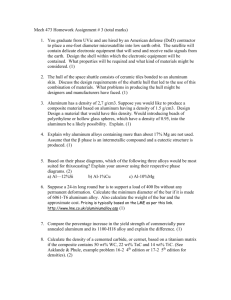
Materials Science and Engineering A 527 (2010) 1704–1708
Contents lists available at ScienceDirect
Materials Science and Engineering A
journal homepage: www.elsevier.com/locate/msea
Characterization of 6061-T6 aluminum alloy to AISI 1018 steel interfaces during
joining and thermo-mechanical conditioning
Emel Taban a,b,∗ , Jerry E. Gould c , John C. Lippold a
a
b
c
The Ohio State University, Dept. of Industrial, Welding and System Engineering, 1248 Arthur E. Adams Drive, Columbus, OH 43221, USA
Kocaeli University, Engineering Faculty, Dept. of Mechanical Engineering, Umuttepe Campus, Kocaeli 41380, Turkey
Edison Welding Institute, Edison Joining and Technology Center, 1248 Arthur E. Adams Drive, Columbus, OH 43221, USA
a r t i c l e
i n f o
Article history:
Received 14 September 2009
Received in revised form 27 October 2009
Accepted 28 October 2009
Keywords:
Welding
Steels
Aluminum alloys
Intermetallic compounds
Electron microscopy
a b s t r a c t
Friction welds between 6061-T6 aluminum alloy and AISI 1018 steel have been examined in the as process
condition and following thermo-mechanical treatment. Joints were characterized by microhardness mapping, focused ion beam with ultra high resolution scanning electron microscopy and transmission electron
microscopy with energy dispersive spectrum. Intermetallic layer thicknesses at the interfaces ranged
from 250 to 400 nm. These intermetallics appear related to the FeAl and Fe2 Al5 phases for as-welded
condition and FeAl, Fe2 Al5 , FeAl3 and FeAl6 phases following thermo-mechanical condition.
© 2009 Elsevier B.V. All rights reserved.
1. Introduction
Economic and environmental considerations are constantly
driving the automotive industry to unique designs and material
combinations for both weight reduction and structural integrity. In
particular, there is an increasing interest in lightweight materials.
Materials that have been considered for vehicle structures in recent
years include advanced high strength, composites, magnesium and
aluminum. Of these, aluminum has been seen to offer specific
advantages in terms of strength, density and availability. The cost
of aluminum compared to steel has restricted its use for automobile
parts. However, aluminum can be used more economically when it
is incorporated into hybrid structures with steel. The introduction
of aluminum alloy parts into a steel car body requires welding technologies that are reliable, efficient and economical. The formation
of metallurgical bonds between steel and aluminum is challenged
due to significant differences in both physical and metallurgical
properties. Metallurgically, joints between aluminum and steel can
result in multiple intermetallic phases that generally form by solidstate reaction. These intermetallics generally result in mechanical
degradation of the joint. The formation of these phases is mainly
∗ Corresponding author at: Kocaeli University, Engineering Faculty, Dept. of
Mechanical Engineering, Umuttepe Campus, Kocaeli 41380, Turkey.
Tel.: +90 262 303 3405; fax: +90 262 335 2880.
E-mail addresses: emel.taban@yahoo.com, taban.1@osu.edu (E. Taban).
0921-5093/$ – see front matter © 2009 Elsevier B.V. All rights reserved.
doi:10.1016/j.msea.2009.10.059
driven by interdiffusion of the species, and is highly dependent
on the specific time and temperature history of the welding process. The extended thermal cycles and higher temperatures/longer
times that are generally associated with fusion welding result in
the formation of thick intermetallic compound (IMC) layers at the
joint interface. The formation of these layers is generally considered the root cause for the property degradation experienced with
these types of joints [1–6]. Solid-state welding techniques provide
joint formation at lower temperatures and often at very short times.
The use of solid-state joining process generally is associated with
reduced formation of these intermetallic phases. One such method,
friction welding, has affectively been used for joining aluminum
to steel in production environments. If properly applied, friction
welding and its variant inertia friction welding provides joining at
relatively low temperatures with an overall short thermal cycle.
Recent research has addressed friction welding material combinations including mainly pure and alloyed aluminum to stainless steel
[7–13].
In order to control the extent of the intermetallic layers in Al–Fe
joints, it is important to understand the formation and growth
behaviour and conditions of the intermetallic compounds. It has
been noted that the types and distribution of phases, which occur
at the interface during friction welding are relatively complex.
An attempt has been made by Fukumoto et al. [11] to understand these mechanisms. The work demonstrated the presence
of both FeAl and Fe3 Al phases. These phases are Fe-rich intermetallic phases with better ductility properties compared to brittle
E. Taban et al. / Materials Science and Engineering A 527 (2010) 1704–1708
Al-rich phases and are generally observed in joints made with
fusion welding processes. Other studies [9,11] also have suggested
that FeAl and Fe3 Al Fe-rich phase formation occured in friction
welding of pure aluminum alloy to stainless steel. Reddy et al.
[9] reported that using an Ag interlayer during friction welding of
stainless steel to 1050 aluminum alloy provided the possible formation of FeAl in addition to Fe2 Al5 . Similarly, Fukumoto et al.
[10,11] reported that mainly Fe2 Al5 formed and Fe3 Al and FeAl
might have been formed during friction welding of non-heat treatable 1050 aluminum alloy to stainless steel. Published studies are
mainly concentrated on dissimilar Al-Fe friction welding of aluminum, especially 1xxx series alloys, to stainless steels. Clearly,
friction welding of aluminum alloys with low alloy steels remains
of strong industrial interest [7–12]. However, the types and distributions of intermetallics that are formed in these types of joints
are not satisfactorily investigated. Thus, this study aims to investigate the formation of intermetallics, in particular, Fe-rich phase
formation such as FeAl and Fe3 Al in joints of heat treatable 6061
aluminum and 1018 low alloy steel during friction welding and
thermo-mechanical conditioning.
2. Material and experimental procedure
Dissimilar joints of 6061-T6 aluminum alloy and AISI 1018 steel
were produced using friction welding with selected parameters due
to the earlier experience [7–11] as well as some iterative experimental trials to provide possibly minimum IMC layer thickness
at the interface. Process parameters included an initial rotational
speed of 4200 rpm, a friction pressure (P1) of 23 MPa and an upset
pressure (P2) of 60 MPa, a friction time (t1) of 1 s; and upset time
(t2) of 5 s. Then a unique physical simulation was done with rapid
heating by Gleeble thermo-mechanical simulator to promote and
characterize intermetallic growth regarding the IMC layer at the
interface of the joints. Particular emphasis concentrated on interfacial microstructure characterization by microhardness mapping,
SEM, EDS, X-ray elemental mapping, focused ion beam with ultra
high resolution SEM capability, TEM, (S)TEM-EDS and electron
diffraction pattern analysis. Attempt was made to observe the conditions of IMC formation in friction welding and whether they are
stable after rapid thermal cycles.
Base metals for this study included a 6061-T6 aluminum alloy
and a 1018 steel. These materials were prepared as rods nominally
12.5 mm in diameter and were welded using inertia friction welding process. Tensile testing of the welds revealed an average value
of 250 MPa.
1705
Thermo-mechanical conditioning was done at Gleeble 3800
physical simulator. The Gleeble allowed the friction welds to be
subjected to a range of secondary time/temperature combinations.
Combinations investigated included temperatures at 400, 450 and
500 ◦ C, and times for 1, 2, 5 and 10 s. Note that, the temperatures at
Gleeble were controlled from the aluminum side of the interfaces.
The temperature data from the steel side of the interfaces were
obtained during Gleeble thermo-mechanical simulation. So, the
temperatures from 400 to 500 ◦ C were provided at the aluminum
interfaces. Of these, only the samples exposed to combinations of
500 ◦ C at 5 and 10 s demonstrated any intermetallic growth for
conditioned joints. The sample rapidly heated to 500 ◦ C for 10 s is
evaluated here and compared to the as-welded specimen.
For microstructural investigations, cross-sections were prepared, polished and mechanically etched. Microhardness measurements on each weld were carried out using an automated-microhardness tester with 50 g load. To produce interfacial hardness
maps, about 2000 indents with a nominal spacing of 120 m were
placed on each sample. The interfacial cross-sections of these welds
were further investigated by scanning electron microscopy.
EDS line analysis and X-ray elemental mapping were also performed using SEM with energy dispersive spectroscopy (EDS)
analysis capability.
X-ray elemental mapping for Al and Fe elements at the interface
of both joints were studied.
To determine the types of the phases that are formed at the
interface of the joints, further investigations were done using
TEM/STEM techniques. A thin foil specimen was extracted from
the interface area using a Helios 600 focused ion beam (FIB) system with ultra high resolution (UHR) SEM capability. This allowed
for enhanced characterization of the intermetallic layer at the joint
interface.
The FIB milling, with in situ sample preparation, was used
to remove transmission electron microscopy (TEM) foil sections
specifically along the aluminum steel interface. TEM/STEM analysis was performed using an analytical 200 kV FE-TEM Tecnai F20
S-Twin TEM equipped with an EDS detector. Bright field, selected
area diffraction techniques were used to investigate the interfacial
microstructure. EDS profiles were obtained in scanning electron
microscopy (STEM) mode as EDS line and area analysis.
3. Results and discussion
Temperature profiles close to the interface of the as-welded and
conditioned joints were obtained with K-type thermocouple mea-
Fig. 1. Thermal cycles (a) during welding TCAl max – 418 ◦ C, TCSt max – 383 ◦ C and (b) during subsequent Gleeble heat treatment TCAl max – 523 ◦ C, TCSt max – 1010 ◦ C.
1706
E. Taban et al. / Materials Science and Engineering A 527 (2010) 1704–1708
Fig. 2. Hardness profiles of the interfaces of (a) as-welded and (b) conditioned joints.
Fig. 3. X-ray elemental mapping of conditioned joint.
surements a few millimeters away from the interfaces are given in
Fig. 1.
Temperature profiles during welding are provided in Fig. 1(a).
During welding, peak temperatures in the steel and aluminum were
observed as 383 and 418 ◦ C, respectively. Further, the duration of
the thermal cycle was significantly longer on the aluminum side
of the joint. The difference in thermal responses for the steel and
aluminum sides of the joint is directly related to the respective
thermal conductivities. Here, the thermal conductivity of the aluminum is roughly three times that of steel suggesting 3/4 of the
developed heat is conducted away through that side of the joint
[14]. This results in both local higher measured temperatures (at
some distance from the joint line) and a longer overall thermal
cycle. Temperature profiles during Gleeble treatment are shown in
Fig. 1(b). Results show some overshoot on the Al side of the joint
(up to 523 ◦ C). On the steel side of the joint, however, this overshoot
was excessive (up to 1010 ◦ C). The overshoot on the steel side is
related to the considerably higher electrical resistivity – roughly a
factor of 4 – of this material compared to the aluminum [14]. As
current flows in the Gleeble, the steel will excessively overheat till
sufficient heat flows to the joint to achieve the set temperature. At
that point, the temperature will stabilize. Of note, the temperature
at the location of the thermocouple in the steel for the steady state
set temperature at the interface (500 ◦ C) is roughly 660 ◦ C.
The microhardness maps for both as-welded and conditioned
joints are presented in Fig. 2.
The results show a distinct change in hardness between the aluminum and the steel at the bond line. Of interest, little variation in
hardness is observed from each base metal up to the weld interface,
but a step change in transversing from aluminum to steel could be
observed. Some hardness variation suggesting a heat affected zone
on the steel side is observed. This may be related to re-austenization
and subsequent decomposition since, as mentioned above, peak
temperatures in the steel away from the interface were in excess of
1000 ◦ C during thermo-mechanical conditioning. The uniformity of
hardness on the aluminum side suggests a minimal heat affected
zone resulting from either welding or thermo-mechanical conditioning.
SEM photos in secondary electron and backscatter electron
modes of the aluminum–steel interface on the as-welded and
thermal conditioned samples suggested a thin, discontinuous intermetallic layer at the bondline growing into the aluminum side of
the joints. The layer thickness appears to be less than 1 m. The
EDS traces along the joints from Fe to Al sides also suggest some
amount of interdiffusion, particularly from iron side into the aluminum. The apparent width of the diffusion field here is relatively
small compared to the electron activation volume of about 3 m, so
results were considered qualitative. The electron activation volume
of the equipment for X-ray elemental mapping was in the range
of 1–2 m, however the elemental interdiffusion and intermetallic
layer was distinguished (Fig. 3).
UHR SEM photos of the joint interfaces are given in Fig. 4.
Fig. 4. UHR SEM images in SE mode of (a) as-welded and (b) conditioned joints.
E. Taban et al. / Materials Science and Engineering A 527 (2010) 1704–1708
1707
atures above 1200 ◦ C facilitate the formation of Fe-rich FeAl and
Fe3 Al intermetallic phases. This is not likely for friction welds, in
that this is well above the melting point for the aluminum substrate.
It may be that the intimate contact between the species combined
with the heavy working on the aluminum side of the joint can facilitate the atomic diffusion phenomena to overcome the activation
barrier to form this phase [4–6,8,10].
4. Conclusions
In this work, resulting microstructures of inertia friction welds
and thermo-mechanically conditioned joints between a 6061-T6
aluminum alloy and 1018 steel have been characterized. Specific
conclusions from this work include:
Fig. 5. Bright field TEM image with Line EDS scan across the interface and the
selected area diffraction pattern of IMC.
Fig. 4(a) represents the as-welded condition of the workpieces.
Note the fine distribution of the intermetallic phase along the bond
line. A similar UHR SEM micrograph for the thermo-mechanically
conditioned sample is shown in Fig. 4(b). Note that this micrograph
is at the twice the magnification of Fig. 4(a). Here, the intermetallic
is more continuous along the bond line.
Average intermetallic penetrations were approximately 250 and
350 nm for the as-welded and thermo-mechanically conditioned
samples respectively. Maximum thicknesses of the intermetallics
were generally measured at the center of the samples with values
of around 350 and 400 nm for as-welded and conditioned joints
respectively. A bright field TEM image of conditioned sample combined with EDS line analysis and selected area diffraction pattern
is shown in Fig. 5.
The aluminum side of the joint demonstrates the darker contrast in this image. Aluminum, iron and silicon EDS line scans taken
in STEM mode across the bond line are presented in the same figure. These results clearly show a well-defined intermetallic layer,
with a range of associated Al/Fe compositions. These results have
been translated into actual Al/Fe/Si compositions as a function of
location. It should be noted that IMC layer thickness rather than
chemistry constitutes the main emphasis in the published research
[15]. The compositional results obtained by STEM-line EDS suggest that the possible intermetallic compound types found at the
interfaces include FeAl and Fe2 Al5 for as-welded joint. The STEMEDS line compositional analyses suggest that these phases are also
present in the thermo-mechanical conditioned joint. However, it
appears that there is secondary formation of the FeAl3 and FeAl6
non-equilibrium phases seem to be formed. Diffraction pattern
analysis for the thermo-mechanical conditioned sample shows a
cubic structure which is consistent with FeAl type of phase [16].
Fe2 Al5 is commonly found in solid state and fusion welds of dissimilar steel and aluminum joints. However, as suggested above,
FeAl is seldom found to be formed in friction welding of Al–Fe
joints [9,10]. It has been reported in those studies that temper-
1. Sound joining of 6061-T6 aluminum to AISI 1018 steel has been
provided by inertia friction welding (FW).
2. Thermo-mechanical conditioning by physical simulator providing rapid heating was successfully done which allowed the
interfaces to be subjected to a range of secondary time and
temperature combinations under a constant load. Combinations
investigated included temperatures (at the aluminum interface)
from 400 to 500 ◦ C, and times from 1 to 10 s. Of these, only the
samples exposed to combinations of 500 ◦ C at 5 and 10 s demonstrated any intermetallic growth. The sample rapidly heated to
500 ◦ C for 10 s was evaluated here and compared to an as-welded
specimen.
3. For the as-welded condition, average intermetallic layer thicknesses were approximately 250 nm while 350 nm was measured
for the thermo-mechanically conditioned samples. Maximum
thicknesses of the intermetallics were generally measured at the
center of the samples with values of around 350 and 400 nm for
as-welded and conditioned joints respectively.
4. The microstructural characterization by TEM/STEM including
compositional results by STEM/EDS and diffraction pattern analysis suggest two intermetallics are present, including the Fe-rich
FeAl and an Al-rich Fe2 Al5 phases for as-welded joint. For the
thermo-mechanically conditioned joint, it appears that there
seems to be secondary formation of the FeAl3 equilibrium and
FeAl6 non-equilibrium phases in addition to FeAl and Fe2 Al5
phases.
5. Although Fe2 Al5 is commonly found in solid state and fusion
welds of dissimilar steel and aluminum joints, FeAl is seldom
found to be formed in friction welding of Al–Fe joints and it
seems to keep its stability after thermo-mechanical conditioning
in this study.
Acknowledgements
The authors acknowledge the contribution of the State of Ohio,
Department of Development and Thomas Edison Program, which
provided funding in support of Edison Technology and Industry Center services. Colleagues at Edison Welding Institute-Edison
Joining and Technology Center, Department of Industrial, Welding
and System Engineering-Welding and Joining Metallurgy Group,
Computational Materials Group and Department of Materials Science Engineering-Campus Electron Optics Facilities at the Ohio
State University are also acknowledged for their technical support. Assoc. Prof. Dr. S.S. Babu is acknowledged for valuable TEM
discussions.
References
[1] O. Pasic, I. Hajro, D. Hodzic, Welding in the World 51 (2007) 377–384.
[2] C. Thomy, A. Wirth, M. Kreimeyer, F. Wagner, F. Vollertsen, in: Procedings of
the IIW International Conference on Welding and Materials-Technical, Eco-
1708
[3]
[4]
[5]
[6]
[7]
[8]
E. Taban et al. / Materials Science and Engineering A 527 (2010) 1704–1708
nomic and Ecological Aspects, July 1–8, 2007, Dubrovnik&Cavtat, Croatia,
pp. 311–326.
W.B. Lee, M. Schmuecker, U.A. Mercardo, G. Biallasb, S.B. Jung, Scripta Materialia
55 (2006) 355–358.
K.J. Lee, S. Kumai, N. Kawamura, N. Ishikawa, K. Furuya, Materials Transactions
48 (6) (2007) 1396–1405.
K.J. Lee, S. Kumai, Materials Transactions 47 (4) (2006) 1178–1185.
M. Marya, M.J. Rathod, S. Marya, M. Kutsuna, D. Priem, Materials Forum
539–543 (2007) 4013–4018.
T. Yokoyama, Materials Science and Technology 19 (2003) 1418–1426.
A. Fuji, Science and Technology of Welding and Joining 9 (1) (2004) 83–89.
[9] G.M. Reddy, A.S. Rao, T. Mohandas, Science and Technology of Welding and
Joining 13 (7) (2008) 619–628.
[10] S. Fukumoto, T. Inuki, H. Tsubakino, K. Okita, M. Aritoshi, T. Tomita, Materials
Science and Technology 13 (1997) 679–686.
[11] S. Fukumoto, H. Tsubakino, K. Okita, M. Aritoshi, T. Tomita, Scripta Materialia
42 (2000) 807–812.
[12] M. Yilmaz, M. Col, M. Acet, Materials Characterization 49 (2003) 421–429.
[13] Aluminum propeller shaft with constant velocity joint, US Patent 6364779.
[14] www.matweb.com.
[15] C. Maldonado, T.H. North, Journal of Materials Science 37 (2002) 2087–2095.
[16] http://emaps.mrl.uiuc.edu/emaps.asp.







